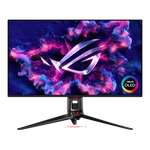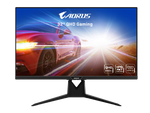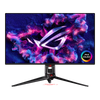A comparison of specs, key information, reviews, and best pricing from top retailers
Last updated -- hours ago | Report incorrect information
What we think

The PerfectRec monitor team Learn more
Updated April 11, 2024·
If you prioritize exceptional contrast and color performance for HDR gaming and media consumption, and have a higher budget, the Asus PG32UCDM (QD-OLED) could be an excellent choice. However, if your focus is mainly on competitive gaming with a good refresh rate and response time, while also having a tighter budget, the Gigabyte FI32Q-X (IPS) will serve you well. The Asus is superior for image clarity and has a glossier screen which can enhance visuals but might reflect light, while the Gigabyte has a matte finish that reduces glare but doesn't excel in color or HDR as much as the Asus. Give Feedback
this description is based on the product variant with some specs and product variant with some specs. At the time of writing, the variant with some specs cost some dollars and the variant with some specs cost some dollars.
Advantages of the Asus PG32UCDM (QD-OLED)
- Best in class for casual gaming
- Good for productivity
- Best in class for media consumption
- Good image clarity
- Best in class contrast
- Best in class color volume
- Best in class response time
Advantages of the Gigabyte FI32Q-X (IPS)
- Good brightness
Key differences
Casual Gaming
9.8


5.9
3840 x 2160
RESOLUTION
2560 x 1440
240Hz
REFRESH RATE
270Hz
Inf:1
NATIVE CONTRAST
1000:1
250 nits
SDR PEAK BRIGHTNESS
400 nits
250 nits
HDR PEAK BRIGHTNESS
600 nits
99.0 %
DCI-P3 COLOR GAMUT
99.0 %
Glossy
COATING
Matte
The Asus PG32UCDM (QD-OLED) is best in class for casual gaming, while the Gigabyte FI32Q-X (IPS) is poor.
Competitive Gaming
6.4


5.3
240Hz
REFRESH RATE
270Hz
0.0 ms
TOTAL RESPONSE TIME
8.0 ms
48 - 240 Hz
VARIABLE REFRESH RATE
48 - 270 Hz
Yes
STROBING / BFI
No
250 nits
SDR PEAK BRIGHTNESS
400 nits
The Asus PG32UCDM (QD-OLED) is only fair for competitive gaming, while the Gigabyte FI32Q-X (IPS) is poor.
Productivity
7.0


4.8
3840 x 2160
RESOLUTION
2560 x 1440
140 PPI
PIXELS PER INCH
91 PPI
Yes
ADJUSTABLE STAND
Yes
Glossy
COATING
Matte
The Asus PG32UCDM (QD-OLED) is good for productivity, while the Gigabyte FI32Q-X (IPS) is poor.
Media Consumption
9.7


5.4
3840 x 2160
RESOLUTION
2560 x 1440
Inf:1
NATIVE CONTRAST
1000:1
250 nits
SDR PEAK BRIGHTNESS
400 nits
250 nits
HDR PEAK BRIGHTNESS
600 nits
Glossy
COATING
Matte
The Asus PG32UCDM (QD-OLED) is best in class for media consumption, while the Gigabyte FI32Q-X (IPS) is poor.
Cost
$1,300


$500
$0
$500
$1,000
$1,500
$2,000
The Asus PG32UCDM (QD-OLED) has a price of $1,300 and the Gigabyte FI32Q-X (IPS) costs $500.
HDR Gaming and Media Consumption
Yes


No
The Asus PG32UCDM (QD-OLED) is suitable for HDR gaming and media consumption while the Gigabyte FI32Q-X (IPS) is not suitable for HDR gaming and media consumption.
Key similarities
Digital Photo Editing
Yes


Yes
Both the Asus PG32UCDM (QD-OLED) and Gigabyte FI32Q-X (IPS) are suitable for digital photo editing.
HDR Video Editing and Color Grading
No


No
Both the Asus PG32UCDM (QD-OLED) and Gigabyte FI32Q-X (IPS) are not suitable for HDR video editing and color grading.
Print Photo Editing
No


No
Both the Asus PG32UCDM (QD-OLED) and Gigabyte FI32Q-X (IPS) are not suitable for print photo editing.
Give feedback
We’re constantly working to improve.
How the Asus PG32UCDM (QD-OLED) and the Gigabyte FI32Q-X (IPS) compare to other monitors
Spec Comparison
| Asus PG32UCDM (QD-OLED) | Gigabyte FI32Q-X (IPS) |
GENERAL | |||
|---|---|---|---|
| Price | |||
$1,300 | $500 | ||
Screen Size | |||
Screen Size | 31.5" | 32" | |
Resolution | |||
Resolution | 3840 x 2160 | 2560 x 1440 | |
Screen Type | |||
Screen Type | OLED | LED | |
Screen Sub-type | |||
Screen Sub-type | QD-OLED | IPS | |
Local Dimming Zones | |||
Local Dimming Zones | N/A | 16 | |
COLOR, CONTRAST & BRIGHTNESS | |||
|---|---|---|---|
Native Contrast | |||
Native Contrast | Inf:1 | 1000:1 | |
SDR Peak Brightness | |||
SDR Peak Brightness | 250 nits | 400 nits | |
HDR Peak Brightness | |||
HDR Peak Brightness | 250 nits | 600 nits | |
Suitable for HDR Gaming and Media Consumption | |||
Suitable for HDR Gaming and Media Consumption | Yes | No | |
sRGB Color Gamut | |||
sRGB Color Gamut | 100 % | 157 % | |
MOTION CHARACTERISTICS | |||
|---|---|---|---|
Total Response Time | |||
Total Response Time | 0.03 ms | 8 ms | |
Variable Refresh Rate | |||
Variable Refresh Rate | 48 - 240 Hz | 48 - 270 Hz | |
Strobing / BFI | |||
Strobing / BFI | Yes | No | |
Persistence Blur Score | |||
Persistence Blur Score | 8/10 | 8.5/10 | |
Ghosting Score | |||
Ghosting Score | 10/10 | 7.6/10 | |
TEXT & IMAGE CLARITY | |||
|---|---|---|---|
Pixels Per Inch | |||
Pixels Per Inch | 140 PPI | 91 PPI | |
Coating | |||
Coating | Glossy | Matte | |
Text Clarity Score | |||
Text Clarity Score | 6.9/10 | 6.1/10 | |
Image Clarity Score | |||
Image Clarity Score | 8/10 | 6.1/10 | |
PORTS & CONNECTIVITY | |||
|---|---|---|---|
HDMI 1.4 Ports | |||
HDMI 1.4 Ports | 0 | 0 | |
HDMI 2.0 Ports | |||
HDMI 2.0 Ports | 0 | 0 | |
HDMI 2.1 Ports | |||
HDMI 2.1 Ports | 2 | 2 | |
Micro HDMI Ports | |||
Micro HDMI Ports | 0 | 0 | |
DisplayPort 1.2 Ports | |||
DisplayPort 1.2 Ports | 0 | 0 | |
Give feedback
We're constantly perfecting our model
More comparisons for you
Compare Asus PG32UCDM (QD-OLED) vs. Asus PG34WCDM (W-OLED)
VS
Compare Asus PG32UCDM (QD-OLED) vs. LG 34GS95QE (W-OLED)
VS
Compare Asus PG32UCDM (QD-OLED) vs. AOC AG456UCZD (W-OLED)
VS
Compare Gigabyte FI32Q-X (IPS) vs. KTC M27T20 (VA MiniLED)
VS
Compare Gigabyte FI32Q-X (IPS) vs. Dell AW2524H (IPS)
VS
Compare Gigabyte FI32Q-X (IPS) vs. LG 32UN650 (IPS)
VS
FAQs
Why trust us
This information was produced and vetted by the PerfectRec monitors team. We are a product research and recommendation organization that meticulously reviews and evaluates the latest monitor information and makes it digestible for you.
By the numbers
210
Monitors evaluated
10,500
Monitors stats compiled
15
Proprietary Monitors ratings developed
117,500
Recommendations made
17,625
Consumer hours saved
About the monitor team
Joe Golden, Ph.D
CEO and Monitors Editor
Joe is an entrepreneur and lifelong electronics enthusiast with a Ph.D in Economics from the University of Michigan.
Jason Lew
Staff Expert & Software Engineer
Jason is a staff expert and software engineer that has been making laptop recommendations for 7 years and moderates one of the largest laptop subreddits.
Chandradeep Chowdhury
Staff Expert & Software Engineer
Chandradeep is a staff expert and software engineer and expert in televisions and monitors. He’s been making monitor recommendations for ten years.







